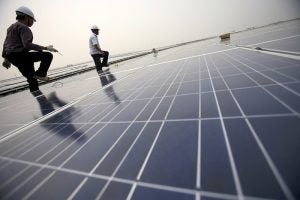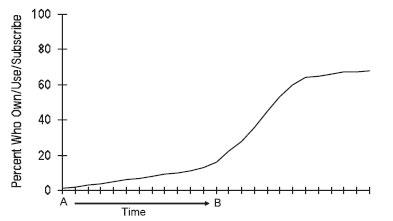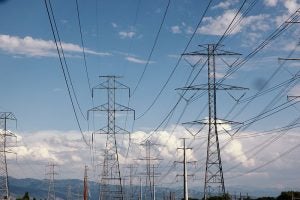With a Record $1.4 Trillion in Sustainability Assets, Investors Bail on Fossil Fuels
By EDF Blogs
 By Namrita Kapur, managing director, Corporate Partnerships
By Namrita Kapur, managing director, Corporate Partnerships
As President-elect Donald Trump puts together his fossil fuel-focused administration, the investment community is moving full speed in the opposite direction, instead putting their bets on emissions reductions and support for clean energy.
Some recent developments:
- Investors controlling more than $5 trillion in assets have committed to dropping some or all fossil fuel stocks from their portfolios, according to a new report tracking the trend.
- Climate change criteria shape the investment of $1.42 trillion in assets under management, a more than fivefold increase since 2014. Clean technology is now a consideration incorporated by money managers with $354 billion in assets under management.
- A recent government bidding process for a large wind farm outside New York State got so many offers the auction had to be extended for a day. The winning bidder was Statoil, an oil company with a growing renewable portfolio willing to pay $42 million, more than twice what the last round of Gulf oil leases generated.
- Microsoft-founder Bill Gates and nearly two dozen other business leaders just launched a new, $1-billion fund that will finance emerging energy innovations to deliver affordable and reliable energy. Breakthrough Energy Ventures’ goal is to reduce global greenhouse gas emissions to near-zero levels.
Why is there so much momentum in the sector now, especially considering the proclivity of the incoming Trump administration for fossil fuels? Because of two short words that mean everything to investors: return and risk.
With a record $1.4 trillion in sustainability assets, investors bail on fossil fuels
Click To Tweet
Price of renewables is right
Although federal policy and the bias of government leaders have an important influence on return and risk, they are far from the only factors. The investment thesis for clean energy is clear.
Prices are dropping, making renewables not only competitive, but ushering in an era of undercutting fossil sources – even without subsidies. Solar energy, for example, is already the lowest-cost option in parts of the world and expected to beat out coal globally by 2025.
Solar energy, for example, is already the lowest-cost option in parts of the world and expected to beat out coal globally by 2025.
In addition, large consumers, looking to insulate themselves from volatility in electricity markets are locking into financially favorable, long-term renewable energy purchases. Corporate power purchasing agreements, or PPAs, had their best year by far in Europe in 2016, totaling more than 1 gigawatt, up from about 400 megawatts in 2015.
Amid coal bankruptcies, investors play it safe
New risks have also cropped up to steer investor behavior.
There is hesitance to fund coal, in particular, as credit ratings have been deteriorating. At least seven coal producers with liabilities of $500 million or more have filed for bankruptcy in the United States since the start of 2014.
Credit downgrades have outnumbered upgrades among coal mining companies this year by about eight to one, Bloomberg data show. Such market realities are immune to politics.
“No turning back”
Besides wanting to address climate change and other risks in their portfolios, investors now seek to reap the rewards of a sector where revenues are outpacing costs and have become a clear value play.
As Pete Grannis, deputy controller at the $185-billion New York State public pension fund, said at an investor side event at the recent international climate talks in Marrakech, “The die has been cast, there is no turning back.”

 The New York Public Service Commission recently approved plans by National Grid, the largest distributor of natural gas in the Northeast, to use advanced leak detection and quantification technologies developed by EDF and Google Earth Outreach in order to maximize the environmental and ratepayer benefits of a three-year, $3 billion capital investment program. This program includes plans to replace 585 miles of old, leak-prone pipes on the company’s systems in Long Island and parts of New York City.
The New York Public Service Commission recently approved plans by National Grid, the largest distributor of natural gas in the Northeast, to use advanced leak detection and quantification technologies developed by EDF and Google Earth Outreach in order to maximize the environmental and ratepayer benefits of a three-year, $3 billion capital investment program. This program includes plans to replace 585 miles of old, leak-prone pipes on the company’s systems in Long Island and parts of New York City.

 California’s three major utilities – Pacific Gas & Electric (PG&E), Southern California Edison (SCE), and San Diego Gas & Electric (SDG&E) – have proposed plans to move Californians to electricity prices that vary with the time of day.
California’s three major utilities – Pacific Gas & Electric (PG&E), Southern California Edison (SCE), and San Diego Gas & Electric (SDG&E) – have proposed plans to move Californians to electricity prices that vary with the time of day. 
 “What happened to oil in the late 1970s?” was a question assigned to me in elementary school to discuss with family over the Christmas holiday break. At the time, this question seemed innocent enough, and I didn’t know how my family would react about what I soon learned to be two oil embargos. Turns out when I brought it up one night, extended family members held a broad spectrum of views on the issue, and the question led to one of the most heated dinner arguments I can recall – until this year, at least. This holiday, family discussions focused on the presidential election. Fierce conversation ensued on standout topics. But, to my dismay, energy and the environment were just an afterthought.
“What happened to oil in the late 1970s?” was a question assigned to me in elementary school to discuss with family over the Christmas holiday break. At the time, this question seemed innocent enough, and I didn’t know how my family would react about what I soon learned to be two oil embargos. Turns out when I brought it up one night, extended family members held a broad spectrum of views on the issue, and the question led to one of the most heated dinner arguments I can recall – until this year, at least. This holiday, family discussions focused on the presidential election. Fierce conversation ensued on standout topics. But, to my dismay, energy and the environment were just an afterthought.


 Market forces and technology are increasingly making old, dirty power plants uneconomic, which creates an opportunity for clean energy progress and cleaner air. However, outdated rules and entrenched interests can complicate the path to a healthier energy economy, as evidenced by a new settlement in Ohio.
Market forces and technology are increasingly making old, dirty power plants uneconomic, which creates an opportunity for clean energy progress and cleaner air. However, outdated rules and entrenched interests can complicate the path to a healthier energy economy, as evidenced by a new settlement in Ohio.